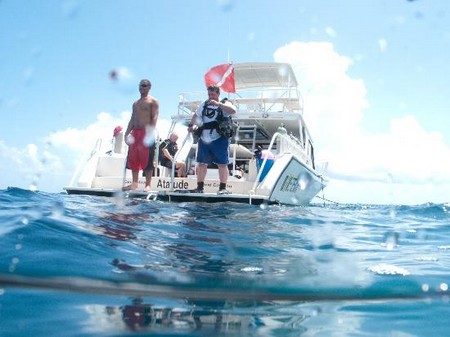Appreciating the job of the person driving the pick-up boat will help your boat driver to work quickly and efficiently and in the safest way possible.
For most people who drive small boats, ‘person-overboard’ drills are used very rarely. For the driver of a small boat that drops off and picks up divers, these manoeuvres are a routine exercise.
Getting you there
Divers must be brought to a site safely. You will be told where to sit in the boat, and you should stay there. The weight and position of a small boat’s load affects its steering and seaworthiness. The passengers should wear some form of permanent buoyancy. In the case of a diver, a wetsuit may be enough. A drysuit with the zip undone is as unsafe as wearing a sea anchor should the wearer fall in the water. You must hold on tightly during the journey, and when you arrive at the dive site, you should wait for further instructions from your driver or guide.
Entering the water
When it is time to get into the water, the boat’s engine will be in neutral or possibly turned off. At this time, the vessel is at the mercy of the waves. It is important that you follow the instructions for getting into the water precisely. You should enter immediately when you are told to do so.
Once you are in the water, you should swim away from the boat. The engine will be restarted, and the driver will need to move off. Boats are like cars with rear-wheel steering. They pivot around the front (bow) so get away from the back (stern), where the propeller is positioned, as quickly as possible.
Keeping watch
While you are underwater, the people in the pick-up boat will be concerned about your whereabouts. They will stay in the immediate area, keeping watch for any diver who may surface with a problem. You should tell the boat crew the maximum time that you will be underwater or when to expect your delayed deployment surface marker buoy to emerge.
It is quite difficult to see the heads of divers on the surface in the vastness of the ocean. A visual signalling device, such as a flag or safety sausage, is essential. It is extremely hard to hear even the loudest whistle over the noise of the engine. The weather may have changed in the time you were submerged, and a storm may be about to break. These are challenging conditions for those looking for individuals floating in the sea.
Picking you up
Divers sometimes surface close to areas that can be unsafe even for small boats to manoeuvre. If you come up next to a reef, the boat crew may shout to you to swim out into open water. They will position the boat so that it is blown by the wind toward you rather than away from you. At this time, the wind and waves may push the boat toward the shallow part of the reef.
You must be careful how you pass your equipment up to the boat, and then climb into the vessel using the techniques you have learned. Keep your fins and mask in place until you are safely aboard. Listen to any instructions that might be given to you by the driver. Never go near a vessel that has its propeller turning. It is a good idea to save any conversations about the dive with your buddy until after everything is stowed, the boat is no longer subject to any hazard and you are safely on your way home.
